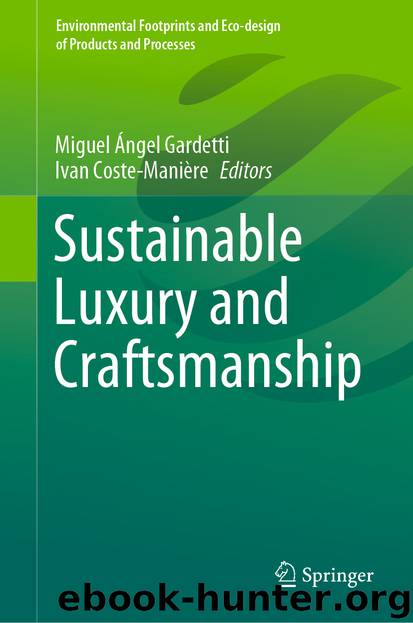Sustainable Luxury and Craftsmanship by Unknown

Author:Unknown
Language: eng
Format: epub
ISBN: 9789811537691
Publisher: Springer Singapore
6 The Challenges Posed by Luxury Growth and the Resolutive Role of Art
While growth and product diffusion are not an issue for premium brands, which indeed benefit from the increase of their market share, they conversely may represent an obstacle for luxury brands’ well-being. In fact, besides the unquestionable short-term economic benefit, sales growth can also cause the exposure of luxury firms to the risk of losing their exclusive appeal and their narrative meaning [42]. In other words, the extension of luxury customer base from the happy few (the powerful élite) to the happy many (the wealthy middle class), thus the transformation of luxury “from the ordinary of the extraordinary people to the extraordinary of the ordinary people” is likely to distance the élite itself, which is populated by those individuals who “ensure the long-term desirability of the brand” [38, p. 373]. Moreover, the expansion of luxury has created a condition of overexposure of luxury brands, which have invaded individuals’ everyday life by massively resorting to generic media channels such as television, newspapers, magazines and Internet [40]. This phenomenon has exacerbated the moral criticisms that always existed around luxury, blamed to foster social inequality. Such arguments call into question the reputation of the luxury sector and even its right to exist [38].
Aware of the above-mentioned issues, Kapferer [25, 38] claimed the centrality of art in the resolution of the problems posed by the growth of luxury. Able to provide a powerful aesthetic and moral endorsement, art can strengthen luxury symbolical authority and offer new segmentation criteria beyond price (such as cultural and humanistic sensitivity), establishing a dialogue with a new, creative and post-materialistic élite populated by those “extraordinary people” who are destined to shape the future. The involvement of art, therefore, not only guarantees the loyalty of the happy few, but also defuses the moral criticisms related to luxury consumption by taking it to a higher and unquestionable level of meaning. Moreover, associating luxury with art may also help discouraging new potential competitors from entering the luxury market. Indeed, competitors may have difficulty decoding and imitating this source of competitive advantage, since the art–business collaborations are usually complex to define, highly specific and tacit [43]. Kastner [44] identified three benefits stemming from the associations between art and luxury brands. Firstly, this association “entrenches in the consumer’s mind the perceptions of originality, ingenuity and inventiveness” (p. 45) and enshrines the aesthetic sensitivity of the brand. Secondly, it enriches brand content and invigorates the aspirational storytelling typical of luxury brands. Thirdly, the art–luxury association elevates luxury brands above the purely commercial dimension.
As reported by Kastner [44], the relationship between art and luxury experienced relevant evolutions over the twentieth century. In the 1930s, the surrealist painters Salvador Dalì and Jean Cocteau partnered with the Italian fashion designer Elsa Schiaparelli in order to bring their creativity in her clothing designs [45], while the Italian shoe manufacturer Ferragamo launched an advertising campaign realized in collaboration with the futurist painter Lucio Venna [46]. In the 1960s,
Download
This site does not store any files on its server. We only index and link to content provided by other sites. Please contact the content providers to delete copyright contents if any and email us, we'll remove relevant links or contents immediately.
Tokyo Geek's Guide: Manga, Anime, Gaming, Cosplay, Toys, Idols & More - The Ultimate Guide to Japan's Otaku Culture by Simone Gianni(1947)
Batik by Rudolf Smend(1720)
Life of Elizabeth I by Alison Weir(1573)
The Little Book of Bettie by Tori Rodriguez & Dita von Teese(1295)
Paris Undressed by Kathryn Kemp-Griffin(1220)
A Victorian Lady's Guide to Fashion and Beauty by Mimi Matthews(1115)
Pretty Iconic by Sali Hughes(1095)
How to Dress by Alexandra Fullerton(1052)
Indigo by Catherine E. McKinley(1042)
101 Things I Learned in Law School by Matthew Frederick(920)
The Language of Fashion by Barthes Roland(915)
Lazy Perfection by Jenny Patinkin(912)
Fashion Victims by Alison Matthews David(910)
The Light of the World by Elizabeth Alexander(909)
Fashion Illustration 1920-1950 by Walter T. Foster(879)
Face Paint: The Story of Makeup by Lisa Eldridge(867)
House of Versace: The Untold Story of Genius, Murder, and Survival by Ball Deborah(865)
Historical Dictionary of the Fashion Industry by Francesca Sterlacci & Joanne Arbuckle(857)
Vogue on: Dolce & Gabbana by Luke Leitch(822)
